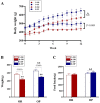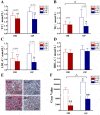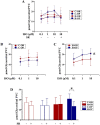Comparison of visceral fat lipolysis adaptation to high-intensity interval training in obesity-prone and obesity-resistant rats
- PMID: 35501906
- PMCID: PMC9063201
- DOI: 10.1186/s13098-022-00834-9
Comparison of visceral fat lipolysis adaptation to high-intensity interval training in obesity-prone and obesity-resistant rats
Abstract
Background/objectives: Visceral obesity is one of the key features of metabolic syndrome. High-intensity interval training (HIIT) could effectively reduce visceral fat, but its effects show strong heterogeneity in populations with different degrees of obesity. The mechanism may be related to the differential adaptation to training between obesity phenotypes, namely obesity prone (OP) and obesity resistant (OR). The aim of the present study was to compare adaptive changes of visceral adipose lipolysis adaptation to HIIT between OP and OR animals and further explore the upstream pathway.
Methods: OP and OR Sprague Dawley rats were established after feeding a high-fat diet for 6 weeks; they were then divided into HIIT (H-OP and H-OR) and control (C-OP and C-OR) groups. After 12 weeks of HIIT or a sedentary lifestyle, animals were fasted for 12 h and then sacrificed for histology as well as gene and protein analysis. Visceral adipocytes were isolated without fasting for catecholamine stimulation and β3-adrenergic receptor (β3-AR) blockade in vitro to evaluate the role of upstream pathways.
Results: After training, there were no differences in weight loss or food intake between OP and OR rats (P > 0.05). However, the visceral fat mass, adipocyte volume, serum triglycerides and liver lipids of OP rats decreased by more than those of OR rats (P < 0.05). Meanwhile, the cell lipolytic capacity and the increase in the expression of β3-AR were higher in the OP compared with OR groups (P < 0.05). Although training did not increase sympathetic nervous system activity (P > 0.05), the cell sensitivity to catecholamine increased significantly in the OP compared with OR groups (P < 0.05). Following blocking β3-AR, the increased sensitivity disappeared.
Conclusion: With HIIT, OP rats lost more visceral fat than OR rats, which was related to stronger adaptive changes in lipolysis. Increased β3-AR expression mediated this adaptation.
Keywords: Adrenergic receptors; HIIT; Obesity prone; Obesity resistance; Visceral adipose.
© 2022. The Author(s).
Conflict of interest statement
All authors declare no potential competing interests.
Figures







Similar articles
-
Post-exercise Effects and Long-Term Training Adaptations of Hormone Sensitive Lipase Lipolysis Induced by High-Intensity Interval Training in Adipose Tissue of Mice.Front Physiol. 2020 Nov 25;11:535722. doi: 10.3389/fphys.2020.535722. eCollection 2020. Front Physiol. 2020. PMID: 33324231 Free PMC article.
-
Fat oxidation, lipolysis, and free fatty acid cycling in obesity-prone and obesity-resistant rats.Am J Physiol Endocrinol Metab. 2000 Oct;279(4):E875-85. doi: 10.1152/ajpendo.2000.279.4.E875. Am J Physiol Endocrinol Metab. 2000. PMID: 11001771
-
Jueming Prescription reduces body weight by increasing the mRNA expressions of beta3-adrenergic receptor and uncoupling protein-2 in adipose tissue of diet-induced obese rats.Chin J Integr Med. 2012 Oct;18(10):775-81. doi: 10.1007/s11655-011-0959-9. Epub 2012 Mar 28. Chin J Integr Med. 2012. PMID: 22457173
-
Effect of High-Intensity Interval Training on Total, Abdominal and Visceral Fat Mass: A Meta-Analysis.Sports Med. 2018 Feb;48(2):269-288. doi: 10.1007/s40279-017-0807-y. Sports Med. 2018. PMID: 29127602 Review.
-
Visceral adiposity and inflammatory bowel disease.Int J Colorectal Dis. 2021 Nov;36(11):2305-2319. doi: 10.1007/s00384-021-03968-w. Epub 2021 Jun 9. Int J Colorectal Dis. 2021. PMID: 34104989 Review.
Cited by
-
The hypothalamic estrogen receptor α pathway is involved in high-intensity interval training-induced visceral fat loss in premenopausal rats.Lipids Health Dis. 2025 Mar 27;24(1):118. doi: 10.1186/s12944-025-02533-6. Lipids Health Dis. 2025. PMID: 40148843 Free PMC article.
-
Associations between novel anthropometric measures and the prevalence of hypertension among 45,853 adults: A cross-sectional study.Front Cardiovasc Med. 2022 Nov 3;9:1050654. doi: 10.3389/fcvm.2022.1050654. eCollection 2022. Front Cardiovasc Med. 2022. PMID: 36407444 Free PMC article.
-
Comparative Hypothalamic Proteomic Analysis Between Diet-Induced Obesity and Diet-Resistant Rats.Int J Mol Sci. 2025 Mar 5;26(5):2296. doi: 10.3390/ijms26052296. Int J Mol Sci. 2025. PMID: 40076916 Free PMC article.
-
High-intensity interval training or lactate administration combined with aerobic training enhances visceral fat loss while promoting VMH neuroplasticity in female rats.Lipids Health Dis. 2024 Dec 18;23(1):405. doi: 10.1186/s12944-024-02397-2. Lipids Health Dis. 2024. PMID: 39696579 Free PMC article.
-
Association of Hibiscus sabdariffa and high-intensity interval training induces reduction in adiposity and beneficial metabolic adaptations in obesity without changes in lipid metabolism.Braz J Med Biol Res. 2024 Nov 4;57:e13676. doi: 10.1590/1414-431X2024e13676. eCollection 2024. Braz J Med Biol Res. 2024. PMID: 39504065 Free PMC article.
References
-
- Lade CG, Andreazzi AE, Bolotari M, et al. Effects of moderate intensity endurance training vs. high intensity interval training on weight gain, cardiorespiratory capacity, and metabolic profile in postnatal overfed rats. Diabetol Metabol Syndr. 2018 doi: 10.1186/s13098-018-0374-x. - DOI - PMC - PubMed
Grants and funding
LinkOut - more resources
Full Text Sources
Research Materials
Miscellaneous

